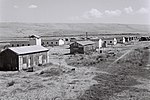Tel Yokneam, also spelled Yoqne'am or Jokneam (Hebrew: תֵּל יָקְנְעָם), is an archaeological site located in the northern part of the modern city of Yokneam Illit, Israel. It was known in Arabic by a variant name, Tell Qamun (Arabic: تل قامون), believed to be a corruption of the Hebrew name. The site is an elevated mound, or tel, spanning around 40 dunams (10 acres/4 ha) and rising steeply to a height of 60 meters (200 ft). With a few brief interruptions, Yokneam was occupied for 4,000 years, from the Middle Bronze Age to the Ottoman Empire.The ancient settlement at Tel Yokneam is first mentioned in Egyptian sources as a city conquered by Pharaoh Thutmose III. It appears later in the Hebrew Bible as a city defeated by Israelite leader Joshua and settled by the Tribe of Levi. It is mentioned twice in Roman sources. During the Crusades, it was called Caymont, or Cain Mons, recalling a legend that Yokneam was the site of Cain's death. For a period, it was the center of the Lordship of Caymont, the smallest seigneurie of the Crusader state of the Kingdom of Jerusalem.The earliest archaeological features of Yokneam date from the Chalcolithic period, in the fourth millennium BCE. The first structures date from the beginning of the second millennium BCE. During the Middle and Late Bronze Ages (2000–1200 BCE), Yokneam was for the most part a fortified city, which was razed during a period known as the Late Bronze Age collapse. During the Iron Age, the city was razed and rebuilt several times; events which are attributed to the biblical accounts of the conquests by Joshua, King David, Hazael of Aram-Damascus, and the Neo-Assyrian Empire. The period between the 10th and 8th centuries BCE is considered Yokneam's golden age, during which it extended beyond the mound's limits. The city was protected at that time by a massive fortification system. During Persian rule (539–330 BC) Yokneam was a dense, unfortified and cosmopolitan city, housing Jews, Phoenicians and Persians. Very little has been found in Yokneam from the Hellenistic, Roman, and Byzantine periods (333 BCE–634 CE), because the settlement was probably located on a different hill, south of Tel Yokneam. The remains of a Byzantine church were found in the southern part of the mound. After the Islamic conquest of 634 AD, a well-planned city was established on the mound by the Abbasid Caliphate. It was gradually abandoned, and was struck by an earthquake in 1033 CE. In the 12th century CE, the Crusaders built a fortified city on the site, the largest since the Iron Age.< The city eventually fell to the Muslims, and was rebuilt by the Mamluks during the 14th century CE. After the Ottoman conquest of 1517 CE, a fortress was built in the 18th century, and later abandoned in the 19th century.The site, which had remained abandoned, was surveyed by the Palestine Exploration Fund in 1878, and by Avner Raban in the 1970s. It was first excavated as part of a "Yoqne'am Regional Project" run by the Hebrew University of Jerusalem and the Israel Exploration Society. The excavations, between 1977 and 1988, were directed by the archaeologist Amnon Ben-Tor. Some of the digs were also headed by Renate Rosenthal and Yuval Portugali. Two other sites were studied in that project: Tel Qashish and Tel Qiri. Further excavations were conducted on the acropolis by Miriam Avissar, in 1993.Today there is an archaeological park and a visitor center on the mound. The park is operated by the Israel Antiquities Authority and the municipality of Yokneam Illit. It was created as part of a conservation project, with the participation of school students from Yokneam Illit.












